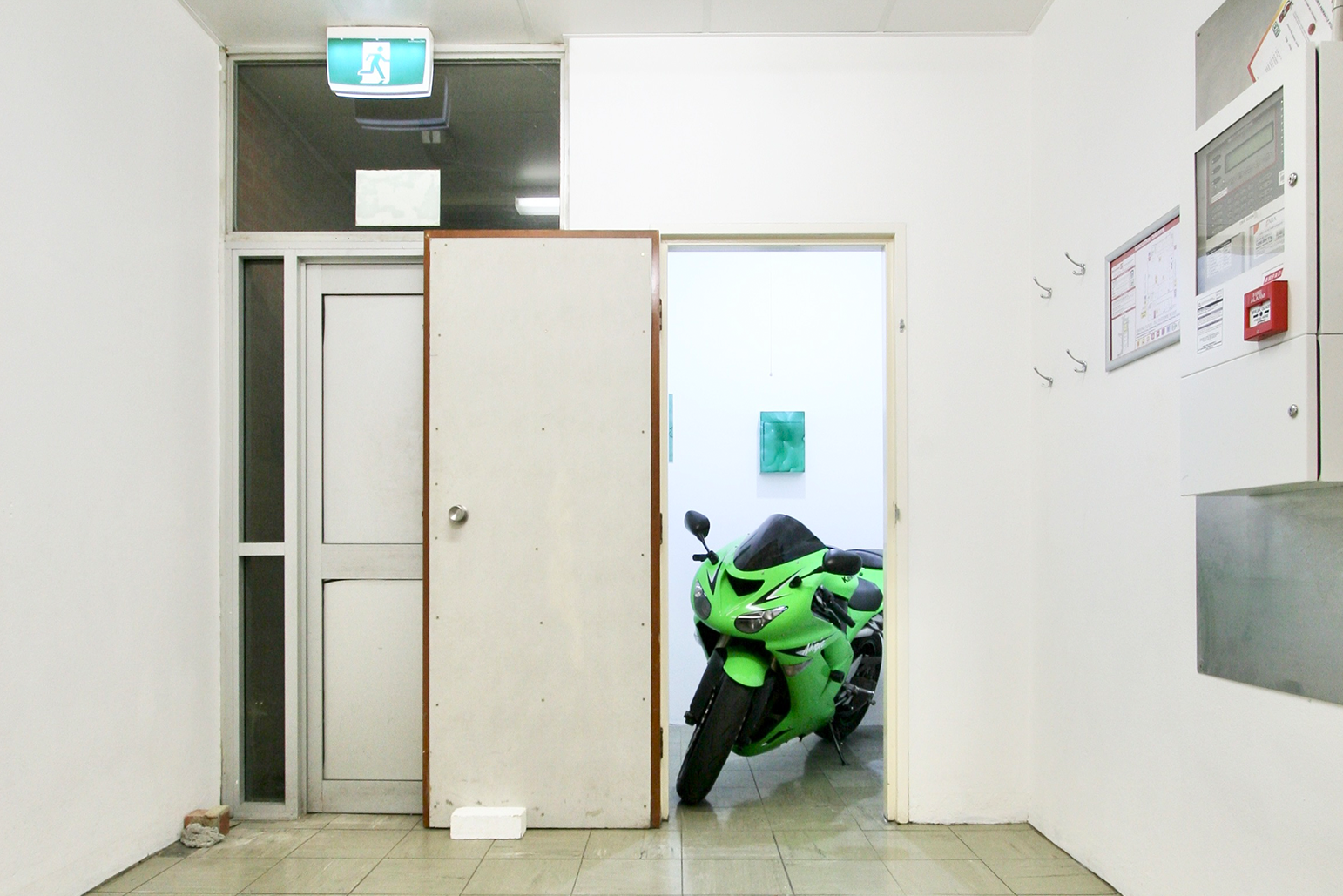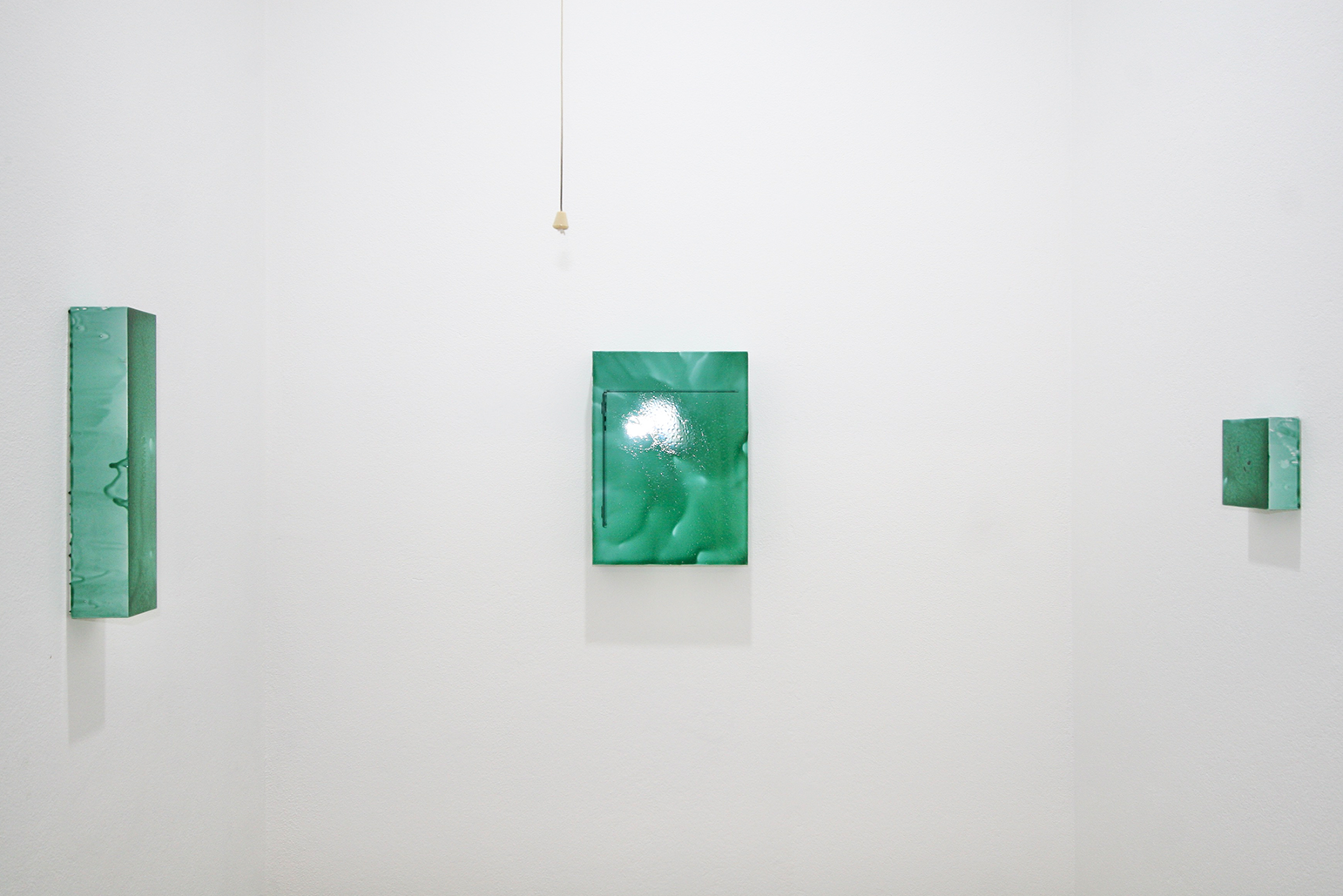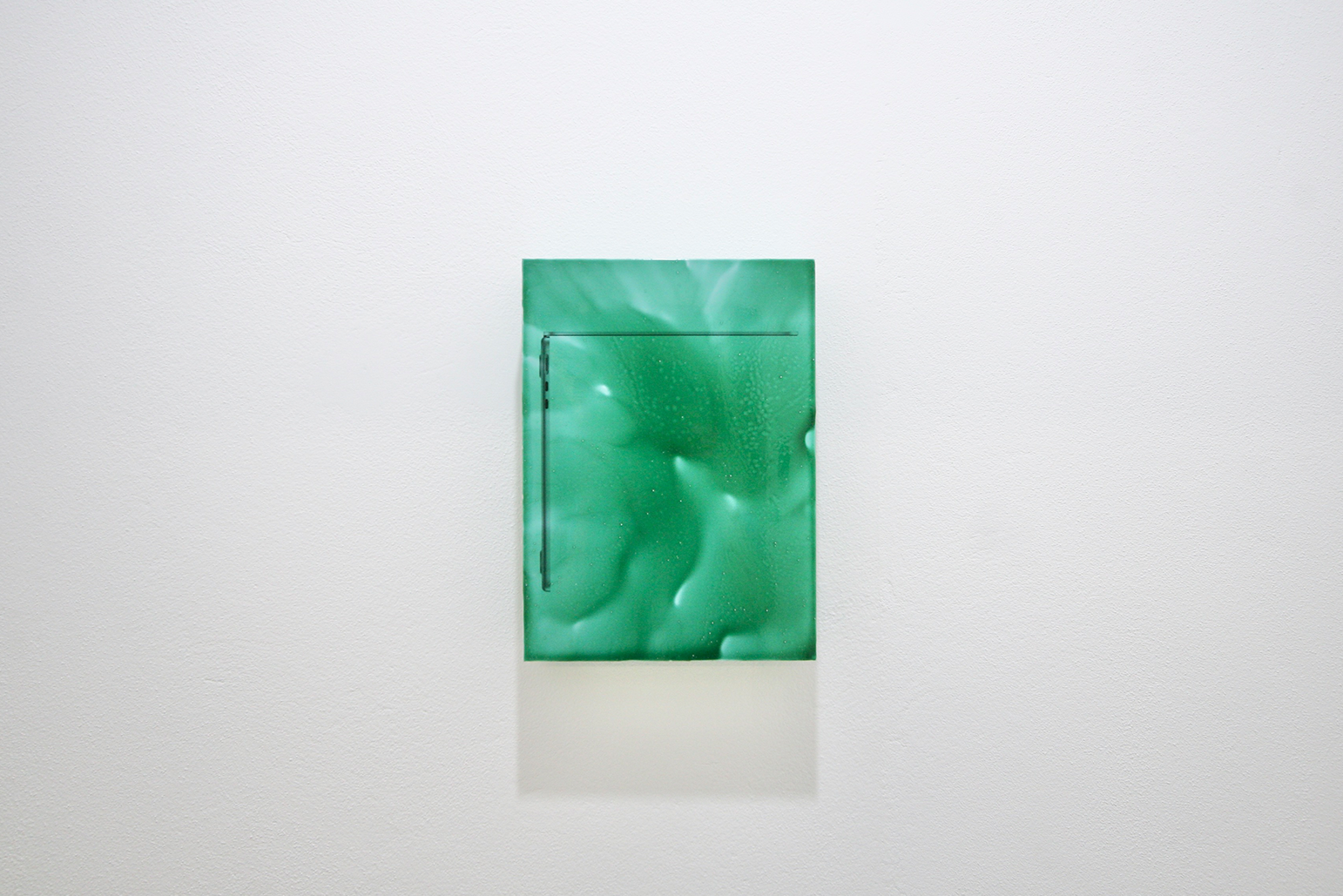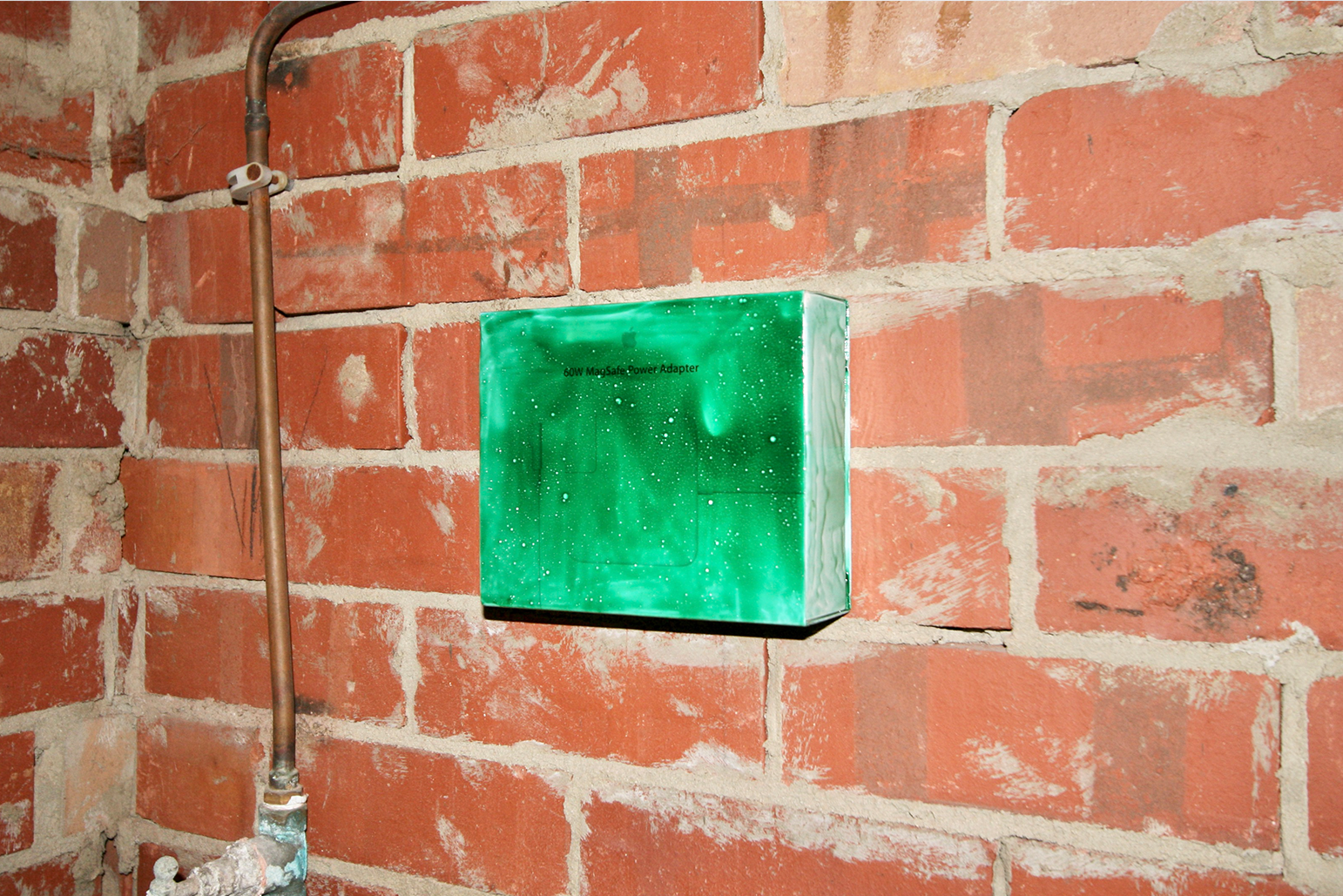





Abstract art, DMT capitalism and the ugliness of David Attwood’s paintings
Sunday, 11 February 2024
David Attwood’s Glue
Paintings exhibition combines paintings done atop Apple packaging with an actual
Kawasaki motorbike, bringing some of the problems of thinking about abstract
art into view. The paintings are a murky green, made with some kind of watered
down glue, and are of the same shade as the motorbike’s decal.
The boxes once packed laptops, keyboards and earphones, and the thin lines of black text identifying an Apple Watch or an AirPod make the boxes seem transparent, as if we are
looking into an algal bloom with a screen inside. It all reminds me of my
teenage nephew’s room, with computer parts coated in layers of adolescent oil,
beds that haven’t been changed for a year, and PCs that glow in a range of
primary colours all day and night behind tightly shut curtains. Attwood’s is a
vision of the future as it plays itself out on YouTube, as the teenagers of the
suburbs fetishise an alternative world of Matrix-like
data. The actual motorbike may as well be digital, lifted out of Grand Theft Auto or Tron, devirtualised out of some stoner fantasy of street life.
There is plumbing in Attwood’s show too, as one of the paintings is installed at the opposite end of Bill’s PC in the Artsource building in Fremantle. One of his green Apple boxes sits between two walls where toilet cisterns flush into the sewage three stories below. Here the toilet rather than the gallery is the context for Attwood’s paintings, and through the toilet the plumbing that extends through the walls and underground and on through the suburbs. Plumbing is the dirty secret that keeps the whole apparatus functioning, but a secret we can ignore with our screens of lucid dreaming.
It was, in any case, a mistake to think that sewage and snot were the subject of Attwood’s show, that Attwood had deliberately made ugly paintings because they brought to mind the unfolding adolescent apocalypse, a mistake revealed when I committed the faux pas not only of criticising an artist’s work, but of doing so in front of the artist himself. Fellow artist Daniel Argyle rushed to his friend’s defence to tell me that Attwood’s paintings were beautiful, and Attwood himself agreed. I should have remembered Argyle’s remarkable 2023 show at Attwood’s own miniature gallery, Disneyland Paris, in which Argyle had splotched paint atop concrete moulds of the various kinds of plastic packaging used to hold supermarket meat.[1] Meat packaging, Apple iPod boxes, you can see the continuity here, with Argyle and Attwood making work out of trash, but they also seem to think they are making trash beautiful. Otherwise why would they make such things, because turning ugly things into ugly things would not make much sense, especially to artists who are attempting to magic objects into some arbitrary, aesthetic space for our consideration. In any case, a gulf opened between myself and the two artists who looked at me expectantly, knowing that whatever politeness might pass between us now we did not understand each other, and any friendship we forged would return again and again to this impasse, this rejection.
I wish I was more like Jerry Saltz, the most popular art critic of this age of Marcusian affirmation who declares how much he loves all art, bad and good, and that all artists should work and keep doing what they are doing, even if they are doing it badly. His Instagram page gets millions of likes, while the haters are banned from contacting him, as if disagreement was impropriety. Contrast Saltz with Dispatch’s most ruthless critic Aimee Dodds, who declares that critics should ‘punch downward’ to keep bad artists out of galleries.[2] Dodds’s is an old school idea of art criticism, one that was more current in the age of the newspaper than it is in the horizontal world of media today, constituted by likes and loves, and where the private company Culture Counts finesse its surveys to ensure institutions return positive and objective reports to their funders.
Of crucial import is the terminology. To call Attwood’s paintings ‘beautiful’ is to present the kind of problem Julian Schnabel and Francesco Clemente presented to the New York artworld in the 1980s. They made deliberately ugly paintings and yet they were so of their historical moment and milieu that people threw hundreds of thousands of dollars at mass produced, messy paintings on crockery and truck tarps. Amidst the cocaine and stock market boom of 1980s New York the aesthetic made sense, and only later after the market had crashed and the flow of money and drugs dried up did the capacity of collectors to distinguish the good from the bad return to them. It was a horizontal moment in which bad art was able to flourish, and our own historical moment is little different. It may be Crown Lager rather than cocaine at Bill’s PC, but the principle of horizontality is the same. Today we are so overexposed to media that it is impossible to see where good and bad painting begin. Nature’s disappearance into David Attenborough documentaries and first-person shooter algorithms has a lot to do with this indifference of perception. Beauty is no longer anchored to an objective ‘outside’, and the human experience is correlated only to itself.[3]
It is impossible to say that Attwood’s paintings are good or bad, because their green blur alludes to the mould that cannot grow on the chemical treatment of Apple’s shiny surfaces, that exist in some super-materialist clutter of Shenzhen appliances fucking each other in a post-internet techno-utopian orgy. Is there not a sense that the DMT aliens have at last climbed down the interdimensional ladder to manifest themselves in the world that these products are building, and that this world is fast eclipsing our own, as our experience is framed by screens that are themselves framed in white and shiny black? Attwood’s goo paintings have no place within this experience that is also their very subject. Their green is the custom chrome decal of the Kawasaki on the gallery floor, but it is a snotty and impotent version of this green, smudged into toxic sewage runoff in adolescent resistance to the DMT invasion. Green is no longer natural but the colour atop the screen that blurs the actual and virtual, impotent and adolescent, because sex between the human and inhuman can only take place because of a mess of ethernet cables and 5G radio pulses, an immaterial contact within an impossible unconscious.
It has been amusing to see The Art Gallery of Western Australia curators attempt to rescue abstract painting from its obsolescence, and from the digital apocalypse itself, in their survey The State of Abstraction. We might say that Attwood’s show solves the doubled problem that Francis Russell identifies in the AGWA show, and that may well haunt any abstract survey of the twenty-first century, in the elusion of coherent content and the market capture of this content-less abstraction.[4] With a careful selection of ready-made Apple packaging and an actual, oversized motorbike beside them, the paintings themselves are of little importance, and become simple illustrations of a facticity that pervades the world beyond the screen. Material questions become more important than conceptual ones, as audience members lean through the narrow door and around the motorbike to see the paintings, ala James Angus’s Truck Corridor (2004). We wonder how Attwood got the bike through the door, and who would lend Attwood an expensive motorbike for this dreary show anyway. The toxic colouration of bike and painting recalls our everyday experience of kitchen and car surfaces, as well as of a twenty-first century art movement that appropriates decal from Patricia Piccinini to Dale Buckley. It’s a corporatisation of abstraction but not as we knew it in the twentieth century, as colour and line are overwritten by the autonomy of the product and production itself, expressionism simulated by the machinations through which products acquire their sheen. The struggle of abstraction is the struggle of market research and computer simulations, the analysis of purchasing trends and careful branding. It’s the convergence and monopolisation of Web 3.0, the DMT alien takeover, the fascination for drawing machines, face altering apps, and corporate aesthetics. It’s how bad painting can be included in a fantastic exhibition and installation, because painting is itself no longer good or bad, but part of an economy in which the material and immaterial are interchangeable, and in which the expression to which abstraction was once indebted is no longer there, in an infinite and numb plasticity.
David Attwood: Glue Paintings runs from 3 February to 4 March 2024 at Bill’s PC.
Footnotes:
1. See https://disneylandparis.net.au/Daniel-Argyle
2. MEMO magazine launch, PICA, 2 November, 2023.
3. Blah blah nerd readers, I know that you know, and if you don’t know ask the tall man in black smoking rollies in the PICA Bar garden.
4. Francis Russell, “State of Abstraction,” Dispatch Review, 7 January 2024, https://dispatchreview.info/State-of-Abstraction
Images courtesy of Bill’s PC.
There is plumbing in Attwood’s show too, as one of the paintings is installed at the opposite end of Bill’s PC in the Artsource building in Fremantle. One of his green Apple boxes sits between two walls where toilet cisterns flush into the sewage three stories below. Here the toilet rather than the gallery is the context for Attwood’s paintings, and through the toilet the plumbing that extends through the walls and underground and on through the suburbs. Plumbing is the dirty secret that keeps the whole apparatus functioning, but a secret we can ignore with our screens of lucid dreaming.
It was, in any case, a mistake to think that sewage and snot were the subject of Attwood’s show, that Attwood had deliberately made ugly paintings because they brought to mind the unfolding adolescent apocalypse, a mistake revealed when I committed the faux pas not only of criticising an artist’s work, but of doing so in front of the artist himself. Fellow artist Daniel Argyle rushed to his friend’s defence to tell me that Attwood’s paintings were beautiful, and Attwood himself agreed. I should have remembered Argyle’s remarkable 2023 show at Attwood’s own miniature gallery, Disneyland Paris, in which Argyle had splotched paint atop concrete moulds of the various kinds of plastic packaging used to hold supermarket meat.[1] Meat packaging, Apple iPod boxes, you can see the continuity here, with Argyle and Attwood making work out of trash, but they also seem to think they are making trash beautiful. Otherwise why would they make such things, because turning ugly things into ugly things would not make much sense, especially to artists who are attempting to magic objects into some arbitrary, aesthetic space for our consideration. In any case, a gulf opened between myself and the two artists who looked at me expectantly, knowing that whatever politeness might pass between us now we did not understand each other, and any friendship we forged would return again and again to this impasse, this rejection.
I wish I was more like Jerry Saltz, the most popular art critic of this age of Marcusian affirmation who declares how much he loves all art, bad and good, and that all artists should work and keep doing what they are doing, even if they are doing it badly. His Instagram page gets millions of likes, while the haters are banned from contacting him, as if disagreement was impropriety. Contrast Saltz with Dispatch’s most ruthless critic Aimee Dodds, who declares that critics should ‘punch downward’ to keep bad artists out of galleries.[2] Dodds’s is an old school idea of art criticism, one that was more current in the age of the newspaper than it is in the horizontal world of media today, constituted by likes and loves, and where the private company Culture Counts finesse its surveys to ensure institutions return positive and objective reports to their funders.
Of crucial import is the terminology. To call Attwood’s paintings ‘beautiful’ is to present the kind of problem Julian Schnabel and Francesco Clemente presented to the New York artworld in the 1980s. They made deliberately ugly paintings and yet they were so of their historical moment and milieu that people threw hundreds of thousands of dollars at mass produced, messy paintings on crockery and truck tarps. Amidst the cocaine and stock market boom of 1980s New York the aesthetic made sense, and only later after the market had crashed and the flow of money and drugs dried up did the capacity of collectors to distinguish the good from the bad return to them. It was a horizontal moment in which bad art was able to flourish, and our own historical moment is little different. It may be Crown Lager rather than cocaine at Bill’s PC, but the principle of horizontality is the same. Today we are so overexposed to media that it is impossible to see where good and bad painting begin. Nature’s disappearance into David Attenborough documentaries and first-person shooter algorithms has a lot to do with this indifference of perception. Beauty is no longer anchored to an objective ‘outside’, and the human experience is correlated only to itself.[3]
It is impossible to say that Attwood’s paintings are good or bad, because their green blur alludes to the mould that cannot grow on the chemical treatment of Apple’s shiny surfaces, that exist in some super-materialist clutter of Shenzhen appliances fucking each other in a post-internet techno-utopian orgy. Is there not a sense that the DMT aliens have at last climbed down the interdimensional ladder to manifest themselves in the world that these products are building, and that this world is fast eclipsing our own, as our experience is framed by screens that are themselves framed in white and shiny black? Attwood’s goo paintings have no place within this experience that is also their very subject. Their green is the custom chrome decal of the Kawasaki on the gallery floor, but it is a snotty and impotent version of this green, smudged into toxic sewage runoff in adolescent resistance to the DMT invasion. Green is no longer natural but the colour atop the screen that blurs the actual and virtual, impotent and adolescent, because sex between the human and inhuman can only take place because of a mess of ethernet cables and 5G radio pulses, an immaterial contact within an impossible unconscious.
It has been amusing to see The Art Gallery of Western Australia curators attempt to rescue abstract painting from its obsolescence, and from the digital apocalypse itself, in their survey The State of Abstraction. We might say that Attwood’s show solves the doubled problem that Francis Russell identifies in the AGWA show, and that may well haunt any abstract survey of the twenty-first century, in the elusion of coherent content and the market capture of this content-less abstraction.[4] With a careful selection of ready-made Apple packaging and an actual, oversized motorbike beside them, the paintings themselves are of little importance, and become simple illustrations of a facticity that pervades the world beyond the screen. Material questions become more important than conceptual ones, as audience members lean through the narrow door and around the motorbike to see the paintings, ala James Angus’s Truck Corridor (2004). We wonder how Attwood got the bike through the door, and who would lend Attwood an expensive motorbike for this dreary show anyway. The toxic colouration of bike and painting recalls our everyday experience of kitchen and car surfaces, as well as of a twenty-first century art movement that appropriates decal from Patricia Piccinini to Dale Buckley. It’s a corporatisation of abstraction but not as we knew it in the twentieth century, as colour and line are overwritten by the autonomy of the product and production itself, expressionism simulated by the machinations through which products acquire their sheen. The struggle of abstraction is the struggle of market research and computer simulations, the analysis of purchasing trends and careful branding. It’s the convergence and monopolisation of Web 3.0, the DMT alien takeover, the fascination for drawing machines, face altering apps, and corporate aesthetics. It’s how bad painting can be included in a fantastic exhibition and installation, because painting is itself no longer good or bad, but part of an economy in which the material and immaterial are interchangeable, and in which the expression to which abstraction was once indebted is no longer there, in an infinite and numb plasticity.
David Attwood: Glue Paintings runs from 3 February to 4 March 2024 at Bill’s PC.
Footnotes:
1. See https://disneylandparis.net.au/Daniel-Argyle
2. MEMO magazine launch, PICA, 2 November, 2023.
3. Blah blah nerd readers, I know that you know, and if you don’t know ask the tall man in black smoking rollies in the PICA Bar garden.
4. Francis Russell, “State of Abstraction,” Dispatch Review, 7 January 2024, https://dispatchreview.info/State-of-Abstraction
Images courtesy of Bill’s PC.
